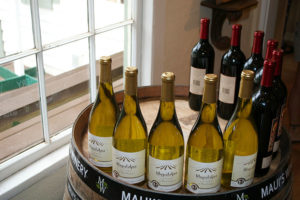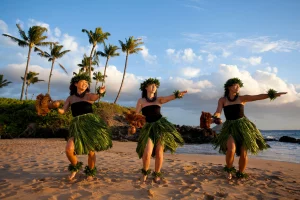By Lehia Apana
Haleakala. The name alone evokes an air of magic. It ripples off the tongue until slowly dissolving into a whispered exhale. Simply saying the word summons a cloud of mystique — one that is only realized by experiencing the mountain firsthand.
Translated as “House of the Sun,” Haleakala is quite literally the stuff of legends. The story goes, it was here that the demigod Maui captured the sun as it passed overhead, slowing it just long enough to afford his mother, Hina, enough time to dry her Kapa (bark cloth).
Haleakala lives up to its name, beckoning each day with a dramatic awakening. Experiencing the sunrise from atop the 10,023-foot mountain is no easy task. Early birds must brave the 2-hour drive from central Maui that weaves up 37 miles of snaking pavement.
Once at the summit, blurry-eyed visitors quietly gather at the edge of the observation deck. There, under layers of thermals, they wait. As if setting the stage for the grand finale, the faintest hints of pink and gold color the sky. Then perfectly on cue, the sun coyly flirts with the new day, breaking ever so gently over the Technicolor horizon.
Haleakala’s summit is a place that exists as a world unto itself, bearing little resemblance to the Maui most people know. Absent are the palm trees and Pacific waters. Gone are the white sandy beaches and fertile rain forests. The naked environment at its peak is more likely to be the backdrop of a sci-fi movie than the subject of a tropical postcard.
Native Hawaiians consider the area a physical manifestation of the fire goddess Pele, and thus a place that should be regarded as sacred. An area now known as Na ‘Iwi O Pele (The Bones of Pele) refers to mounds of broken lava, remnants of a fierce battle between Pele and her sister Namakaokaha’i, goddess of the ocean.
Those with enough energy to get a close-up of the volcano can hike the Keonehe’ehe’e (Sliding Sands) trail, which begins near the visitor center at the summit. The trail zig-zags through rustic landscapes dotted with moon-like peaks and prickly patches of silversword— the only place on earth to see to this bloom.
In fact, Haleakala has the highest number of rare and endangered species of any national park in the United States. And although the area is legally protected against human destruction, invasive species pose the greatest threat to this delicate ecosystem. The volunteer-fueled Friends of Haleakala have answered with monthly service trips that range from invasive species removal to native planting.
Haleakala is more than just the summit. The national park extends down the southeastern flank to Kipahulu, a town bookended between the rural outposts of Hana and Kaupo, where the landscape transforms from a volcanic desert into a vibrant blanket of vegetation sprawling in every direction. With no direct link from the summit to the coast, it is nearly impossible to experience the entire mountain in one day — a blessing considering all there is to see along the way.
Nestled on the flanks of Haleakala at elevations of 1,200 to 2,800 feet lies Kula, also known as Maui’s breadbasket. Farmers tend to some of the island’s most illustrious produce including the world-famous sweet Maui onion and juicy Kula strawberries. The roadside Kula Country Farms offers a true farm-to-tummy experience, inviting visitors and locals to savor fruits and vegetables harvested by local growers. The panoramic views of the central Maui valley are just a bonus.
Maui’s version of turning leaves rivals even the brightest New England autumn. Every spring, Kula’s green vistas are replaced by lavender-hued jacaranda trees, which lure no shortage of Plein air painters who flock to set up an easel.
A drive towards Makawao town is where cowboy charm meets boutique chic. Storefronts hearken an era where four-hoofed traffic ruled the streets and the still-standing hitching posts saw plenty of action. Beyond the rustic facade are delicately crafted homeware, fine art, luxurious threads, a bookstore, and even a gourmet bistro.
Heed the gravitational pull toward the surfer-chic town of Paia. Avoid the four-lane Haleakala Highway, and instead navigate the twists of charming Bald win Avenue, which begins at the edge of Makawao town and winds through the residential enclaves of Ha‘iku and Hali‘imaile.
Although small in size, Paia teems with personality. Its bikini and surf shops, casual eateries, and laid-back ambiance attract a diverse lot. Don’t be surprised if you hear Brazilian or German accents from the windsurfers sharing the sidewalks or spot a high-heeled fashionista crossing paths with a barefoot hippie. Here, yoga and massage studios live in peace with antique shops and galleries, trendy boutiques, and a bustling fish joint that anchors the main corner in town.
From Baldwin Avenue, head east on Hana Highway to reach Haleakala’s other half — Kipahulu. You’ll pass waterfalls, jungles, and majestic coastal views to get here, and upon arrival, you’ll find … not much going on. That’s the point. It may be the most relaxing spot on the planet.
A place that is sure to draw a crowd, however, is the famous ‘O‘heo Gulch (Seven Sacred Pools). While seven is more than enough to set the scene, there are many others that make up this natural aqua park. For another dose of water-soaked adventure, head to the nearby Pipiwai trail, where you’ll witness a string of waterfalls, the final being the 400-foot Waimoku Falls.
Here, Haleakala’s striking diversity is evident. From the summit’s arid expanse to the sheltered Shangri-La of Kipahulu, the mountain seems to mold and transform before one’s very eyes. That, after all, may just be the magic of Haleakala. to-tummy experience, inviting visitors and locals to savor fruits and vegetables harvested by local growers. The panoramic views of the central Maui valley are just a bonus.







